High Latitude Ionospheric Gradient Observation Results from a Multi-Scale Network
Abstract
:1. Introduction
2. Receiver Cluster and Data
3. Data Processing
4. Results and Discussion
4.1. Data Analysis
4.2. Ionospheric Spatial Gradient Characterization Results
5. Conclusions and Future Work
Author Contributions
Funding
Data Availability Statement
Acknowledgments
Conflicts of Interest
References
- Warnant, R.; Foelsche, U.; Aquino, M.; Bidaine, B.; Gherm, V.; Hoque, M.M.; Kutiev, I.; Lejeune, S.; Luntama, J.-P.; Spits, J.; et al. Mitigation of ionospheric effects on GNSS. Ann. Geophys. 2009, 52, 373–390. [Google Scholar] [CrossRef]
- Datta-Barua, S.; Walter, T.; Pullen, S.; Luo, M.; Blanch, J.; Enge, P. Using WAAS Ionospheric Data to Estimate LAAS Short Baseline Gradients. In Proceedings of the ION National Technical Meeting (ION NTM 2002), Anaheim, CA, USA, 28–30 January 2002; pp. 523–530. [Google Scholar]
- Dehel, T.; Lorge, F.; Warburton, J.; Nelthropp, D. Satellite Navigation vs. the Ionosphere: Where Are We, and Where Are We Going? In Proceedings of the 17th International Technical Meeting of the Satellite Division of The Institute of Navigation (ION GNSS 2004), Long Beach, CA, USA, 21–24 September 2004; pp. 375–386. [Google Scholar]
- Ene, A.; Qiu, D.; Luo, M.; Pullen, S.; Enge, P. A Comprehensive Ionosphere Storm Data Analysis Method to Support LAAS Threat Model Development. In Proceedings of the ION National Technical Meeting 2005 (ION NTM 2005), San Diego, CA, USA, 24–26 January 2005; pp. 110–130. [Google Scholar]
- Komjathy, A.; Sparks, L.; Mannucci, A.J.; Coster, A. The Ionospheric Impact of the October 2003 Storm Event on WAAS. In Proceedings of the 17th International Technical Meeting of the Satellite Division of The Institute of Navigation (ION GNSS 2004), Long Beach, CA, USA, 21–24 September 2004; pp. 1298–1307. [Google Scholar]
- Stankov, S.; Jakowski, N. Ionospheric effects on GNSS reference network integrity. J. Atmos. Sol.-Terr. Phys. 2006, 69, 485–499. [Google Scholar] [CrossRef]
- Foster, J.C.; Coster, A.; Erickson, P.; Holt, J.M.; Lind, F.D.; Rideout, W.; McCready, M.; Van Eyken, A.; Barnes, R.J.; Greenwald, R.; et al. Multiradar observations of the polar tongue of ionization. J. Geophys. Res. Atmos. 2005, 110, A09S31. [Google Scholar] [CrossRef]
- Pokhotelov, D.; Fernandez-Gomez, I.; Borries, C. Polar tongue of ionisation during geomagnetic superstorm. Ann. Geophys. 2021, 39, 833–847. [Google Scholar] [CrossRef]
- Van der Meeren, C.; Oksavik, K.; Lorentzen, D.; Moen, J.I.; Romano, V. GPS scintillation and irregularities at the front of an ionization tongue in the nightside polar ionosphere. J. Geophys. Res. Space Phys. 2014, 119, 8624–8636. [Google Scholar] [CrossRef]
- Carlson, H.C.; Oksavik, K.; Moen, J.; Pedersen, T. Ionospheric patch formation: Direct measurements of the origin of a polar cap patch. Geophys. Res. Lett. 2004, 31, L08806. [Google Scholar] [CrossRef]
- Weber, E.J.; Klobuchar, J.A.; Buchau, J.; Carlson, H.C.; Livingston, R.C.; de la Beaujardiere, O.; McCready, M.; Moore, J.G.; Bishop, G.J. Polar cap F layer patches: Structure and dynamics. J. Geophys. Res. Atmos. 1986, 91, 12121–12129. [Google Scholar] [CrossRef]
- Lockwood, M.; Carlson, H.C. Production of polar cap electron density patches by transient magnetopause reconnection. Geophys. Res. Lett. 1992, 19, 1731–1734. [Google Scholar] [CrossRef]
- Xiong, C.; Yin, F.; Luo, X.; Jin, Y.; Wan, X. Plasma patches inside the polar cap and auroral oval: The impact on the spaceborne GPS receiver. J. Space Weather Space Clim. 2019, 9, A25. [Google Scholar] [CrossRef]
- Crowley, G. Critical Review on Ionospheric Patches and Blobs. Review of Radio Science, 1992–1996; Stone, W.R., Ed.; Oxford University Press: New York, NY, USA, 1996; pp. 619–648. [Google Scholar]
- Crowley, G.; Ridley, A.J.; Deist, D.; Wing, S.; Knipp, D.J.; Emery, B.A.; Reinisch, B.W. Transformation of high-latitude ionospheric F region patches into blobs during the March 21, 1990, storm. J. Geophys. Res. Space Phys. 2000, 105, 5215–5230. [Google Scholar] [CrossRef] [Green Version]
- Jin, Y.; Moen, J.I.; Miloch, W.J.; Clausen, L.B.N.; Oksavik, K. Statistical study of the GNSS phase scintillation associated with two types of auroral blobs. J. Geophys. Res. Space Phys. 2016, 121, 4679–4697. [Google Scholar] [CrossRef]
- Jin, Y.; Moen, J.I.; Oksavik, K.; Spicher, A.; Clausen, L.B.; Miloch, W.J. GPS scintillations associated with cusp dynamics and polar cap patches. J. Space Weather Space Clim. 2017, 7, A23. [Google Scholar] [CrossRef]
- Tsunoda, R.T. High-latitude F region irregularities: A review and synthesis. Rev. Geophys. 1988, 26, 719–760. [Google Scholar] [CrossRef]
- Spicher, A.; Deshpande, K.; Jin, Y.; Oksavik, K.; Zettergren, M.D.; Clausen, L.B.N.; Moen, J.I.; Hairston, M.R.; Baddeley, L. On the Production of Ionospheric Irregularities Via Kelvin-Helmholtz Instability Associated with Cusp Flow Channels. J. Geophys. Res. Space Phys. 2020, 125, e2019JA027. [Google Scholar] [CrossRef]
- Bisai, N.; Sen, A. Physical Origin of Short Scale Plasma Structures in the Auroral F Region. J. Geophys. Res. Space Phys. 2021, 126, e2020JA028. [Google Scholar] [CrossRef]
- Wübbena, G.; Bagge, A.; Seeber, G.; Böder, V.; Hankemeier, P. Reducing distance dependent errors for real-time precise DGPS applications by establishing reference station networks. In Proceedings of the 9th International Technical Meeting of the Satellite Division of The Institute of Navigation (ION GPS 1996), Kansas City, MO, USA, 17–20 September 1996; pp. 1827–1836. [Google Scholar]
- Han, S.; Rizos, C. GPS Network design and error mitigation for real-time continuous array monitoring systems. In Proceedings of the 9th International Technical Meeting of the Satellite Division of The Institute of Navigation (ION GPS 1996), Kansas City, MO, USA, 17–20 September 1996; pp. 1827–1836. [Google Scholar]
- Dai, L.; Han, S.; Wang, J.; Rizos, C. Comparison of Interpolation Algorithms in Network-Based GPS Techniques. Navigation 2003, 50, 277–293. [Google Scholar] [CrossRef]
- Caamano, M.; Juan, J.M.; Felux, M.; Gerbeth, D.; González-Casado, G.; Sanz, J. Network-based ionospheric gradient monitoring to support GBAS. Navigation 2021, 68, 135–156. [Google Scholar] [CrossRef]
- Marini-Pereira, L.; de Oliveira Moraes, A.; Pullen, S. A Simple and Effective Approach to Real-Time Ionospheric Monitoring for GBAS in Low Latitudes. In Proceedings of the 35th International Technical Meeting of The Satellite Division of the Institute of Navigation (ION GNSS+ 2022), Denver, CO, USA, 19–23 September 2022; pp. 2954–2969. [Google Scholar]
- Datta-Barua, S.; Lee, J.; Pullen, S.; Luo, M.; Ene, A.; Qiu, D.; Zhang, G.; Enge, P. Ionospheric Threat Parameterization for Local Area Global-Positioning-System-Based Aircraft Landing Systems. J. Aircr. 2010, 47, 1141–1151. [Google Scholar] [CrossRef]
- Luo, M.; Pullen, S.; Dennis, J.; Konno, H.; Xie, G.; Walter, T.; Enge, P.; Datta-Barua, S.; Dehel, T. LAAS Ionosphere Spatial Gradient Threat Model and Impact of LGF and Airborne Monitoring. In Proceedings of the 16th International Technical Meeting of the Satellite Division of The Institute of Navigation (ION GNSS 2003), Portland, OR, USA, 9–12 September 2003; pp. 2255–2274. [Google Scholar]
- Lee, J.; Pullen, S.; Datta-Barua, S.; Enge, P. Assessment of Ionosphere Spatial Decorrelation for Global Positioning System-Based Aircraft Landing Systems. J. Aircr. 2007, 44, 1662–1669. [Google Scholar] [CrossRef]
- Wanninger, L. Ionospheric disturbance indices for RTK and network RTK positioning. In Proceedings of the 17th International Technical Meeting of the Satellite Division of The Institute of Navigation (ION GNSS 2004), Long Beach, CA, USA, 21–24 September 2004; pp. 2849–2854. [Google Scholar]
- Srinivas, V.S.; Sarma, A.D.; Reddy, A.S.; Reddy, D.K. Investigation of the effect of ionospheric gradients on gps signals in the context of Laas. Prog. Electromagn. Res. B 2014, 57, 191–205. [Google Scholar] [CrossRef] [Green Version]
- Pi, X.; Mannucci, A.J.; Lindqwister, U.J.; Ho, C.M. Monitoring of global ionospheric irregularities using the Worldwide GPS Network. Geophys. Res. Lett. 1997, 24, 2283–2286. [Google Scholar] [CrossRef]
- Robert, E.; Jonas, P.; Vuillaume, J.; Salos, D.; Hecker, L.; Yaya, P. Development of a European ionosphere threat model in support of GBAS deployment. In Proceedings of the 2018 IEEE/ION Position, Location and Navigation Symposium (IEEE/ION PLANS 2018), Monterey, CA, USA, 23–26 April 2018; pp. 1181–1190. [Google Scholar] [CrossRef]
- Jung, S.; Lee, J. Long-term ionospheric anomaly monitoring for ground based augmentation systems. Radio Sci. 2012, 47, RS4006. [Google Scholar] [CrossRef]
- Lee, J.; Jung, S.; Pullen, S. Enhancements of Long Term Ionospheric Anomaly Monitoring for the Ground-Based Augmentation System. In Proceedings of the 2011 International Technical Meeting of The Institute of Navigation (ION ITM 2011), San Diego, CA, USA, 24–26 January 2011; pp. 930–941. [Google Scholar]
- Menvielle, M.; Berthelier, A. The K-derived planetary indices: Description and availability. Rev. Geophys. 1991, 29, 415–432. [Google Scholar] [CrossRef]
- Sugiura, M.; Kamei, T. Equatorial Dst Index; 1957–1986; International Association of Geomagnetism and Aeronomy: Paris, France, 1991; Volume 40, pp. 7–14. [Google Scholar]
- ICAO. Annex 10 to the Convention on International Civil Aviation; Aeronautical Telecommunications: Kingston, Canada, 2018; Volume I: Radio Navigation Aids. [Google Scholar]
- Lee, J.; Pullen, S.; Datta-Barrua, S.; Enge, P. Assessment of Nominal Ionosphere Spatial Decorrelation for LAAS. In Proceedings of the 2006 IEEE/ION Position, Location and Navigation Symposium (IEEE/ION PLANS 2006), San Diego, CA, USA, 25–27 April 2006; pp. 506–514. [Google Scholar]
- Pullen, S.; Park, Y.S.; Enge, P. Impact and mitigation of ionospheric anomalies on ground-based augmentation of GNSS. Radio Sci. 2009, 44, RS0A21. [Google Scholar] [CrossRef]
- Mitchell, C.N.; Alfonsi, L.; Defranceschi, G.; Lester, M.; Romano, V.; Wernik, A.W. GPS TEC and scintillation measurements from the polar ionosphere during the October 2003 storm. Geophys. Res. Lett. 2005, 32, L12S03. [Google Scholar] [CrossRef]
- Jin, Y.; Moen, J.I.; Miloch, W.J. On the collocation of the cusp aurora and the GPS phase scintillation: A statistical study. J. Geophys. Res. Space Phys. 2015, 120, 9176–9191. [Google Scholar] [CrossRef]
- Jacobsen, K.S.; Dähnn, M. Statistics of ionospheric disturbances and their correlation with GNSS positioning errors at high latitudes. J. Space Weather Space Clim. 2014, 4, A27. [Google Scholar] [CrossRef] [Green Version]
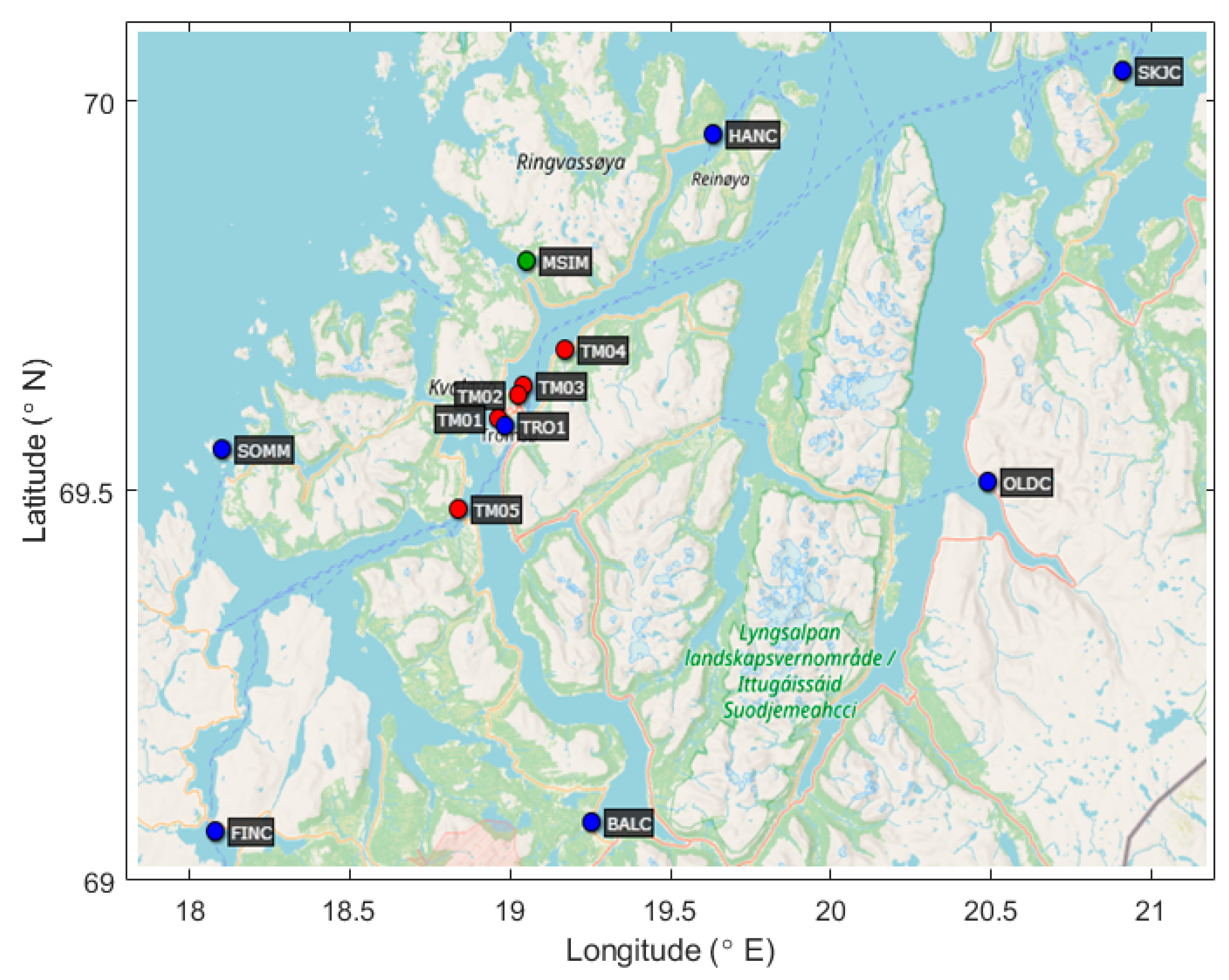
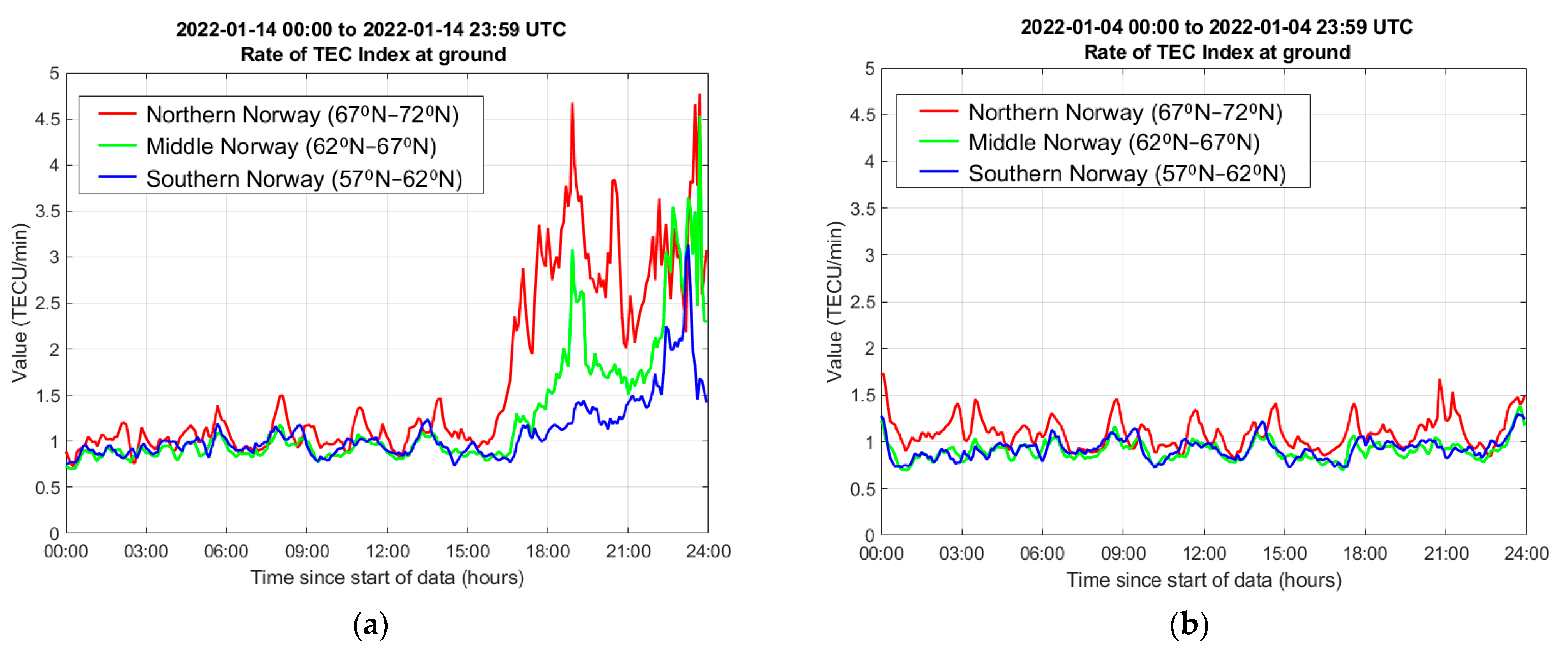

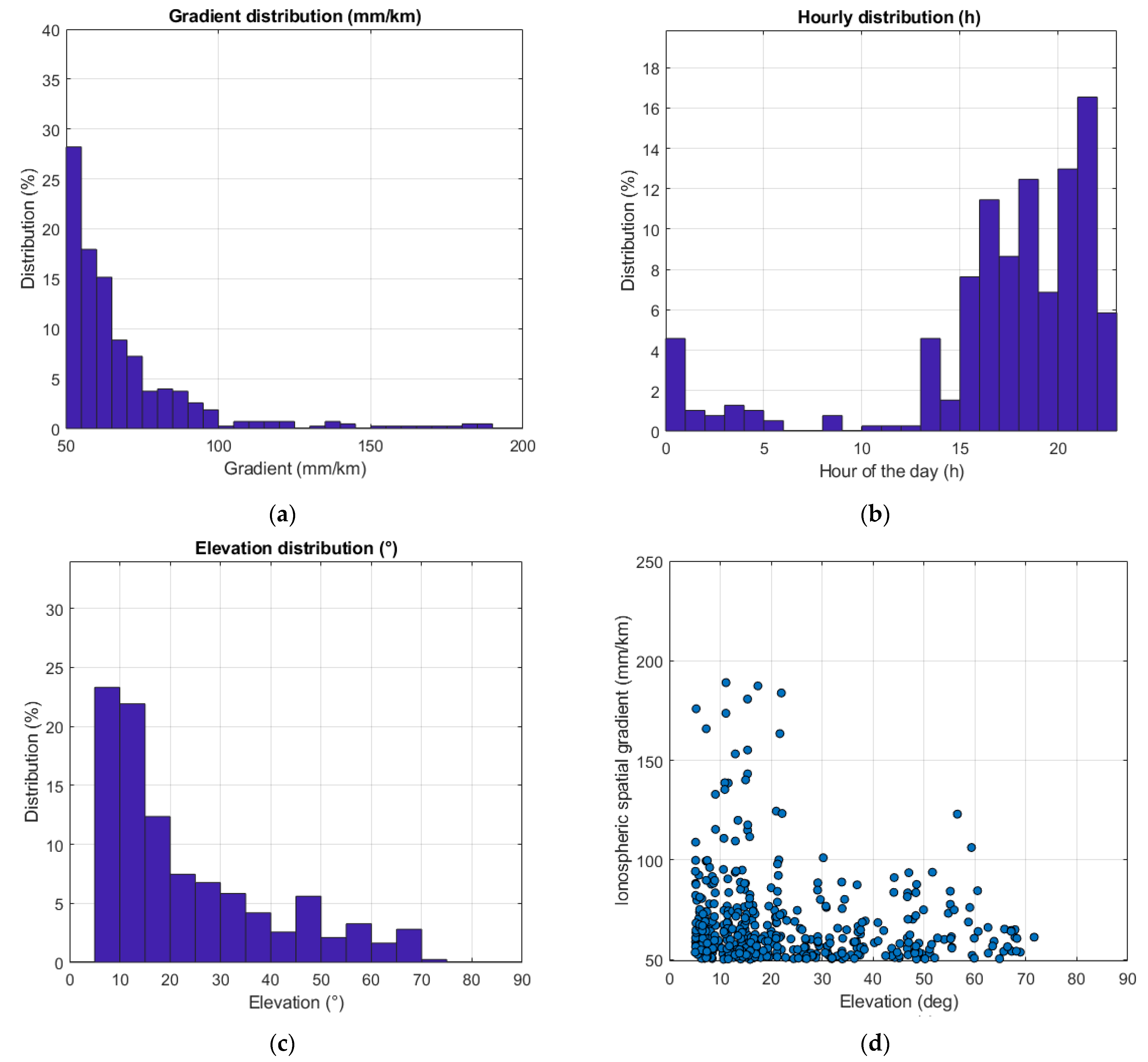
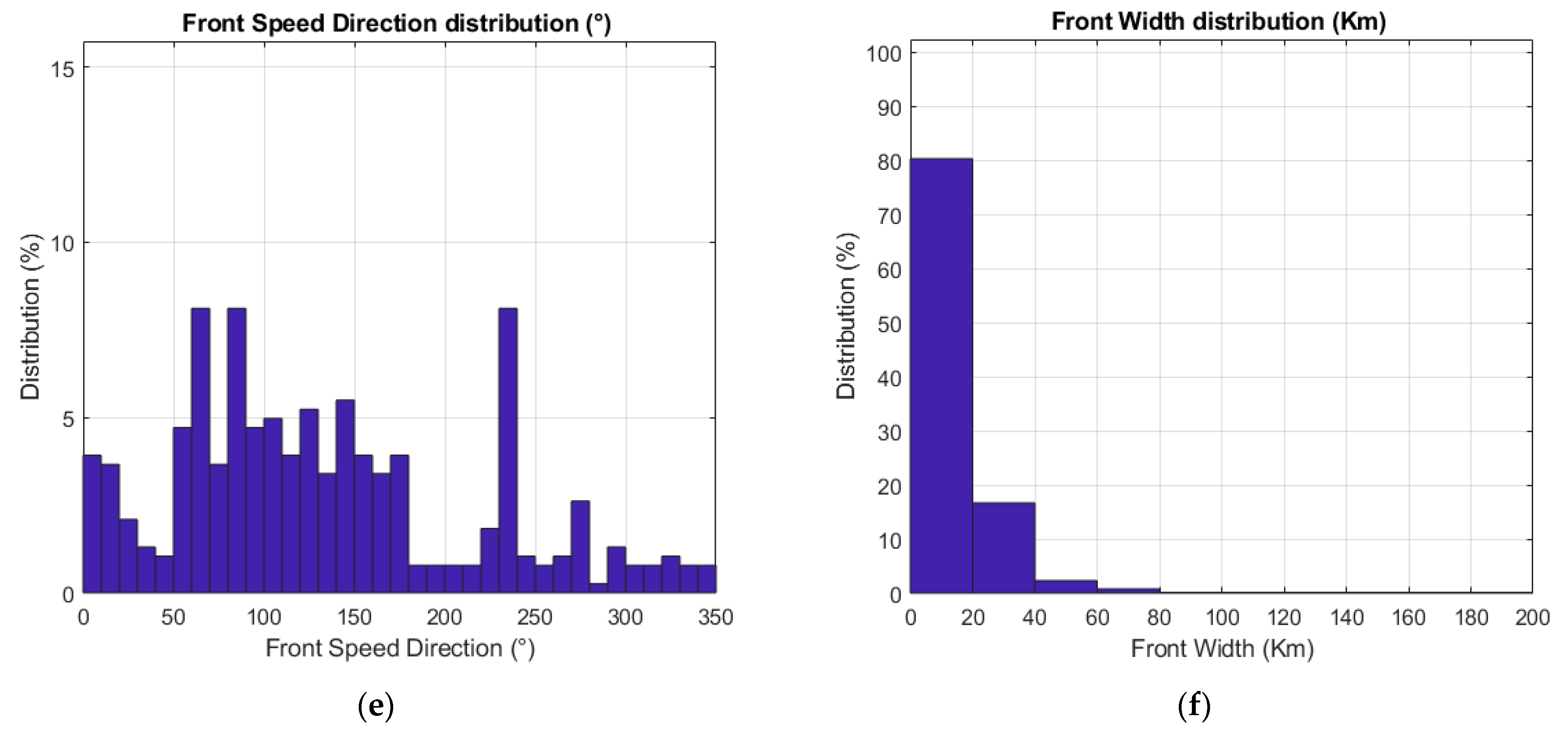
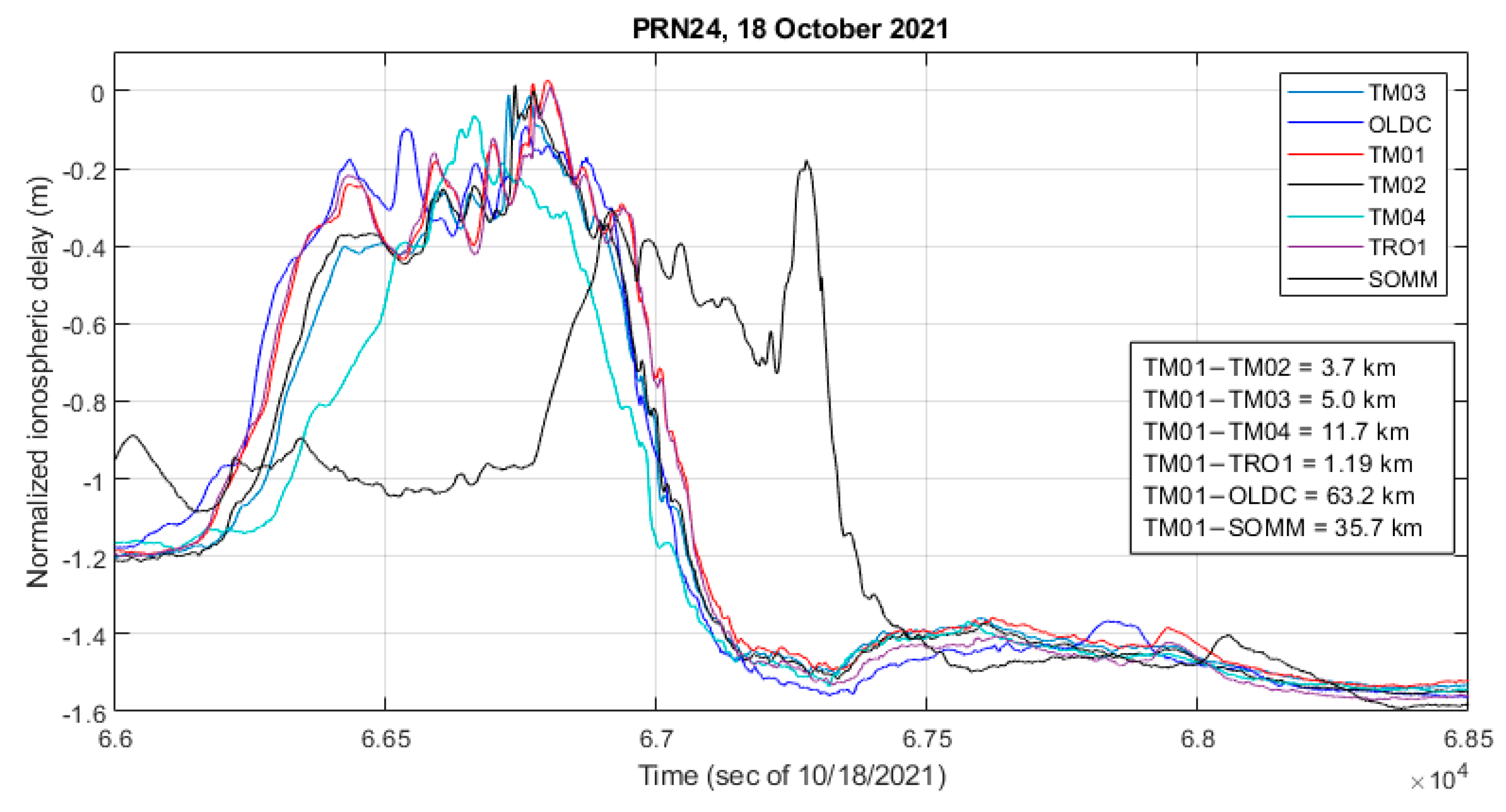
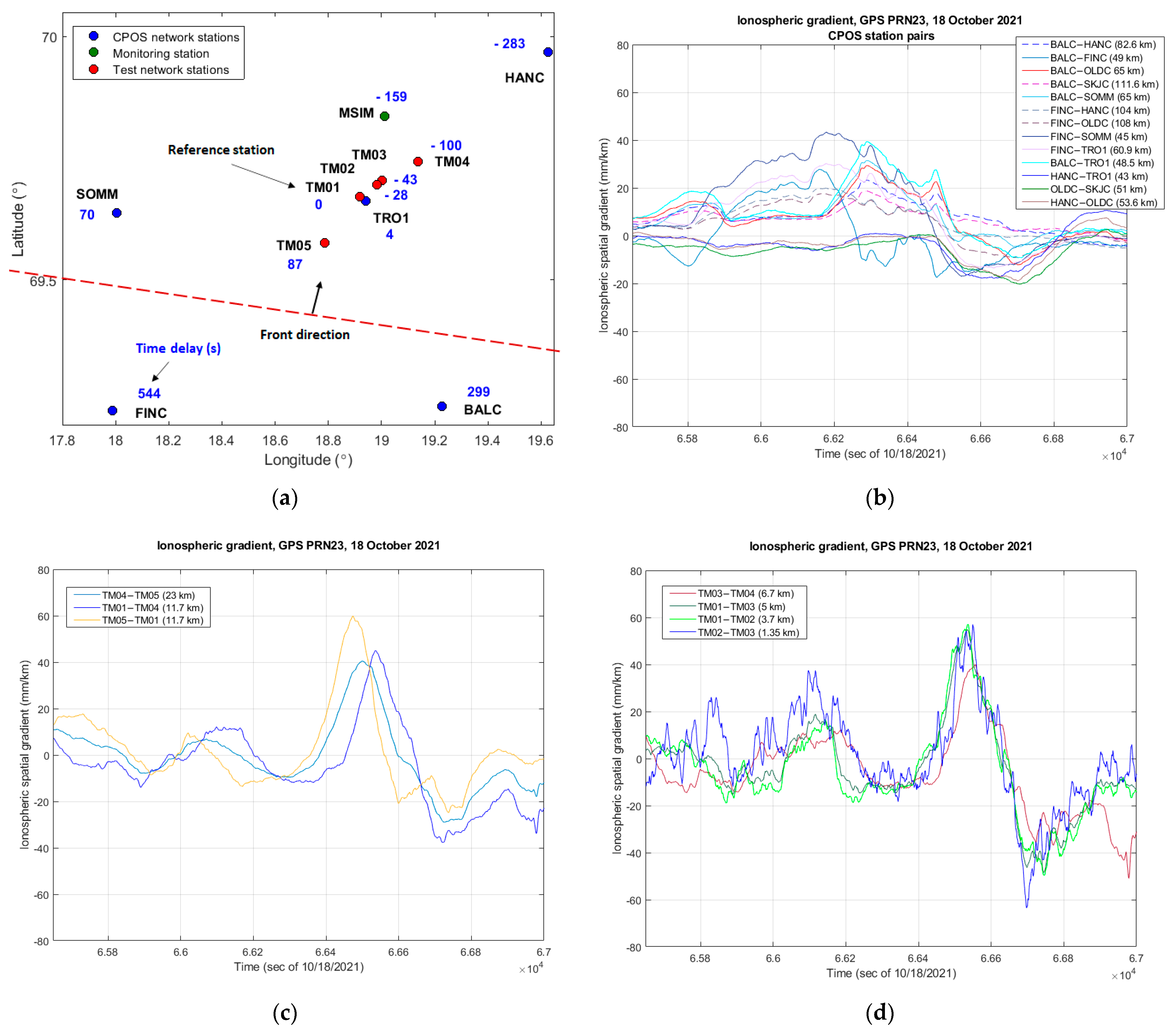
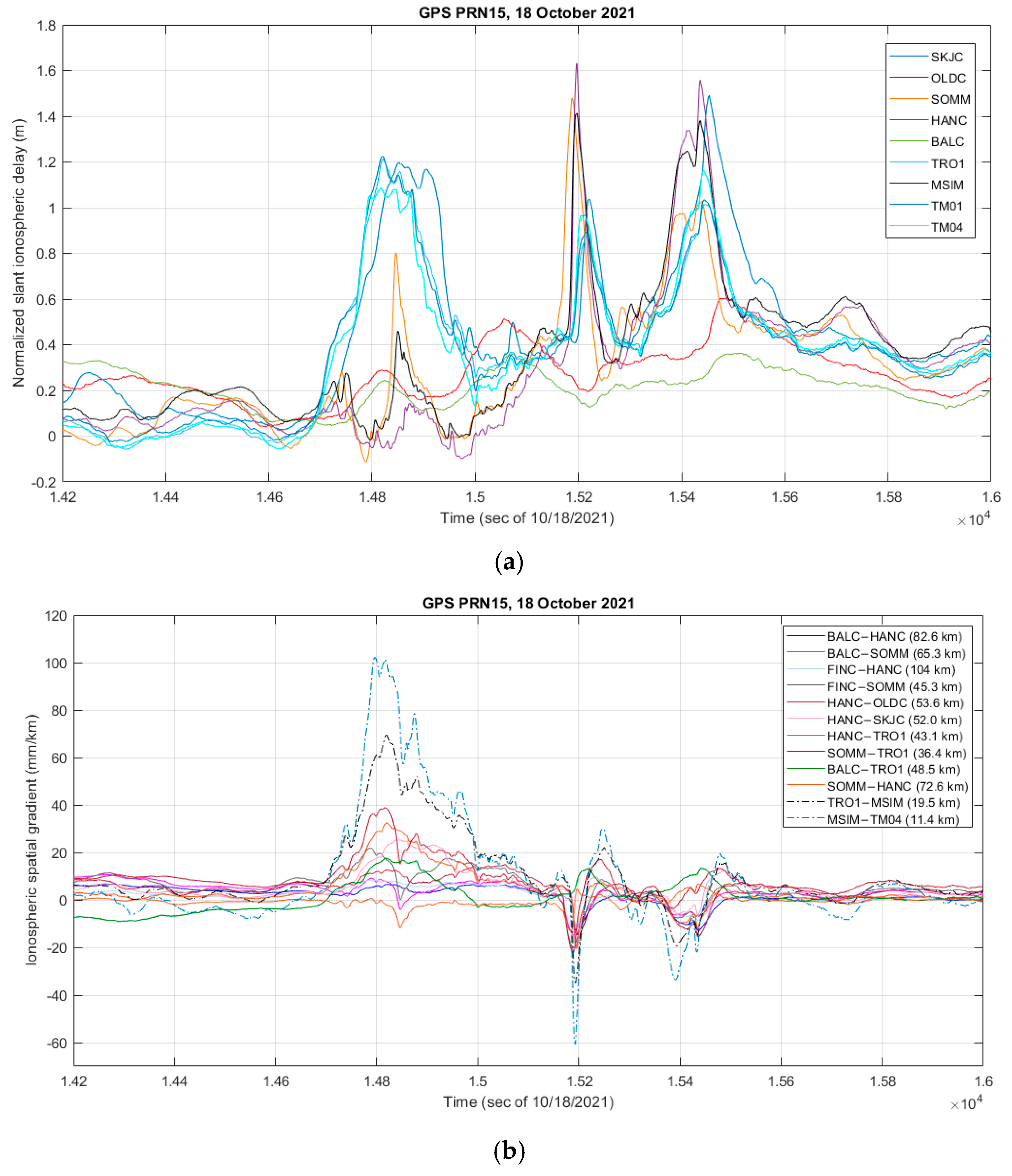

| Station Code | Latitude (° N) | Longitude (° E) | Receiver Model |
|---|---|---|---|
| TM01 | 69.670 | 18.918 | Leica GR50 |
| TM02 | 69.695 | 18.982 | Leica GR50 |
| TM03 | 69.705 | 19.001 | Leica GR50 |
| TM04 | 69.743 | 19.136 | Leica GR50 |
| TM05 | 69.576 | 18.784 | Leica GR50 |
| BALC | 69.240 | 19.226 | Trimble NetR9 |
| FINC | 69.231 | 17.987 | Trimble NetR9 |
| HANC | 69.968 | 19.626 | Trimble NetR9 |
| OLDC | 69.604 | 20.534 | Trimble NetR9 |
| SKJC | 70.034 | 20.976 | Trimble NetR9 |
| SOMM | 69.637 | 18.004 | Trimble NetR9 |
| TRO1 | 69.663 | 18.939 | Trimble NetR9 |
| MSIM | 69.835 | 19.011 | TPS NET-G5 |
| Sampling rate (prior manual validation) | 30 s for initial processing |
| Elevation mask | 5° |
| Ionosphere height | 350 km above the earth surface |
| Ionospheric gradient detection threshold | 50 mm/km |
| Minimum number of points above threshold to declare detection | 1 |
| Ionospheric front speed computation: | |
| 20 m/s 2000 m/s 5 m/s |
| Distance between stations (min, max) | min: 1 km; max: 150 km |
Disclaimer/Publisher’s Note: The statements, opinions and data contained in all publications are solely those of the individual author(s) and contributor(s) and not of MDPI and/or the editor(s). MDPI and/or the editor(s) disclaim responsibility for any injury to people or property resulting from any ideas, methods, instructions or products referred to in the content. |
© 2023 by the authors. Licensee MDPI, Basel, Switzerland. This article is an open access article distributed under the terms and conditions of the Creative Commons Attribution (CC BY) license (https://creativecommons.org/licenses/by/4.0/).
Share and Cite
Sokolova, N.; Morrison, A.; Jacobsen, K.S. High Latitude Ionospheric Gradient Observation Results from a Multi-Scale Network. Sensors 2023, 23, 2062. https://doi.org/10.3390/s23042062
Sokolova N, Morrison A, Jacobsen KS. High Latitude Ionospheric Gradient Observation Results from a Multi-Scale Network. Sensors. 2023; 23(4):2062. https://doi.org/10.3390/s23042062
Chicago/Turabian StyleSokolova, Nadezda, Aiden Morrison, and Knut Stanley Jacobsen. 2023. "High Latitude Ionospheric Gradient Observation Results from a Multi-Scale Network" Sensors 23, no. 4: 2062. https://doi.org/10.3390/s23042062






